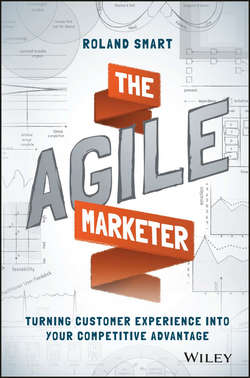Читать книгу The Agile Marketer - Smart Roland - Страница 3
На сайте Литреса книга снята с продажи.
Preface
ОглавлениеThe goal of this book is to share some of what I've learned from my own journey as a marketer. My motivation stems from the fact that some of my greatest insights have come from books that I've read while learning my trade in the trenches. Books like Competitive Advantage, Innovation and Entrepreneurship, The Cluetrain Manifesto, The Innovator's Dilemma, Crossing the Chasm, Predictably Irrational, The Lean Startup, and Digital Body Language —to name a few – made me stop and reevaluate how to approach my work. Sometimes they even took me in a completely new direction that proved rewarding. I've applied the insights from these readings over the years in ventures that succeeded and ventures that failed. Throughout my journey, I've been exposed to just about every aspect of marketing. I've also been fortunate to work at companies where I could balance my interest in marketing and product design with my broader interest in entrepreneurialism and business. This explains why I've grown to be a product-oriented marketer who appreciates and embraces contemporary innovation practices.
My interest in marketing technology started in earnest when I joined a consumer packaged goods company as its first employee. Adina was founded and managed by a successful entrepreneur, Greg Steltenpohl, whose previous company, Odwalla, was acquired by The Coca-Cola Company. For three years, I worked with him running the marketing group. We launched three products into national distribution as social marketing became a thing.
After moving to the San Francisco Bay Area to join Adina full time, I quickly became immersed in the marketing technology community. I joined a remarkable user experience (UX) design firm named Adaptive Path (which has since been acquired by Capital One). Adaptive Path was working on some of the most cutting-edge social technologies on behalf of such clients as Flickr, MySpace, and Nokia. Though Adaptive Path specialized in UX design, I probably learned more about marketing there than at any other place I've worked. That's because the company was laser-focused on improving the process by which companies develop products and services with customer experience in mind. Though I did not know this at the time, these same approaches would ultimately transform my view of marketing.
Later I joined Sprout, the first of two marketing technology start-ups where I would be responsible for leading the marketing group. Sprout was acquired by InMobi, at the time the largest independent mobile advertising network. The second company, Involver, was acquired by Oracle, where I am currently the VP of Social and Community Marketing.
Much of my work today centers on the Oracle Technology Network, but I am also part of a cohort of marketers who are focused on modernizing Oracle's own marketing platform with many of the scores of technologies we have acquired, including Eloqua, Responsys, BlueKai, Compendium, Vitrue, and Involver.
It's in this capacity that I've been exposed to the enormity of the challenge that marketers face today. The marketing technology industry is going through a tremendous cycle of innovation. New technologies have yielded unprecedented business value based on deeper insights into customer behavior, but the speed and volume of innovation has also spawned new problems: data fragmentation, platform/product overlap and integration overhead, as well as challenges to management structures and traditional organizational norms.
My hope is that this book will help you overcome some of these challenges in your efforts to modernize your marketing practices and the platforms that support them. Part 1 explains why and how the adaptive development approaches used by development organizations are driving change in the marketer's world. Part 2 examines these approaches in detail and how they work in a marketing context. In Part 3, we explore how adaptive approaches can be integrated with traditional marketing practices, how they change relationships across the C-suite, and how they ultimately lead to better internal alignment. Finally, Part 4 focuses on what modern marketing looks like in practice, how it changes the relationship between the company and its community of customers, and how it uniquely positions marketers as the steward of customer experience.
In short, The Agile Marketer presents ideas to help marketers create a new culture to meet the imperatives of modern marketing. Let me emphasize up front that this book is not intended to be a comprehensive guide to implementation. Such a book would be nearly impossible to write, given how company-specific the cultural transformation that implementation requires must be. But herein you will find numerous examples of the kinds of strategies and tactics that you'd expect to implement as part of a transformation, regardless of your industry, the nature of your organization, or the maturity of your current marketing practice. I hope these ideas help make your journey productive and successful.
Roland Smart
September 2015
